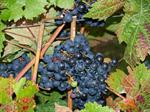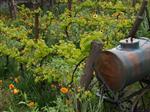 Study This Exciting Course in Viticulture
Study This Exciting Course in Viticulture
Have you always had a passion for growing grapes or owning or
managing a vineyard? Or do you already work in this field and would
like to extend your knowledge?
This course covers all aspects of vineyard management and grape
growing and give you the confidence to forge ahead with your passion.
- Learn to grow grapes
- Choose the right site in the right area
- Analyse weather and the suitability of a region to grape growing
- Choose the right varieties
- For small or large scale
- For fresh or dried fruit
- For wine production
ACS student comments: "[The course] gave me extra knowledge of the industry that I am currently working in. It covered all aspects of the industry. I liked the way you had to work through each lesson/category i received excellent feedback from my tutor. I enjoyed the viticulture course, it has given me extra knowledge that i will use." James McKelvey, Vineyard Manager, Aust - Viticulture course.
Develop an ability to select and cultivate appropriate varieties of grapes in different situations, and provide the knowledge to make informed decisions about the management of a vineyard.
COURSE CONTENT
There are ten lessons as follows:
- Introduction
- Nature and scope of the Viticulture industry both locally and world wide
- Global viticulture
- Major wine growing areas around the world
- The grape; genera and species
- Rootstocks
- Classification of grape varieties
- Table grapes
- Wine grapes
- Dried fruit
- Juice grapes
- Canned grapes.
- Climate and Soils
- Suitable climate and soil conditions for vineyard site establishment
- Temperature; temperature calculations; latitude-temperature index and degree days
- Sunlight
- Rainfall
- Soil; soil types and wine regions; understanding soils; texture; characteristics; soil structure; chemical characteristics of soils including pH and nutrient levels
- Understanding plant nutrition
- Soil water content
- Simple soil tests; naming the soil
- Problems with soil; erosion; salinity; structural decline; soil acidification; chemical residues.
- Selecting Grape Varieties
- Appropriate grape varieties for different situations.
- Grape types
- Selection considerations
- Matching the variety with the site
- Varietal characteristics
- Selecting wine grapes
- Yeild
- Reviewing important varieties; chenin blanc; chardonnay; semillion; muscat ottonel; muscadelle; gewurztraminer; cabernet sauvignon; carignan
- Vitis rotundifolia
- Wine grapes; raisin grapes; juice grapes
- Importance of rootstocks
- Purchasing plants
- Phylloxera.
 Vineyard Establishment
Vineyard Establishment
- Procedure to establish a vineyard.
- Vineyard planning
- Site planning
- Vineyard layout
- Site preparation
- Planting the vines
- Vine spacing
- Shelter belts
- Crop infrastructure
- Equipment
- Grapevine Culture Part A (Training & Pruning)
- Techniques used in the culture of grape vines
- Pruning and training vines
- Shoot spacing
- Bud numbers
- Vine spacing
- How much to prune
- Machine pruning
- Summer pruning
- Combination pruning
- Pruning sultana vines
- Trellising
- Trellis construction
- Guyot system
- Geneva double curtain system
- Head training
- Cordoning
- Kniffen systems
- Umbrella kniffen system
- Pergola training system.
- Grapevine Culture Part B (Weeds, Pests & Diseases)
- Types of Weeds
- Controlling weeds
- Safety procedures when using agricultural chemicals
- Laws and guidelines
- Types of chemicals
- Weed management before planting
- Weed management in new vineyards
- Weed management in established vineyards;
- Integrated pest management
- Pest control in vineyards
- Grape berry moth
- Grape mealy bug
- Grape leaf folder
- Grapevine rust mite
- Grape blossom midge
- Flea beetles
- Birds and large animals
- Disease control in vineyards
- Fungal diseases; rots; mildew; eutypa die back etc
- Bacterial diseases
- Viruses
- Organic culture of grapes; organic pest and disease control
- Companion plants
- Managing environmental problems including air, water, damage, frost, hail, wind and shade
- Water management; runoff; water saving
- Grape clones and varieties.
- Grapevine Culture Part C (Irrigation & Feeding)
- Irrigating and feeding grapes
- Excessive irrigation
- Seasonal effects of irrigation
- Drip irrigation
- Monitoring and timing
- Feasibility of irrigation
- Design considerations
- Soil and water
- Measuring water available to plants
- Calculating permanent wilting point
- Calculating field capacity of a vineyard
- Available moisture range
- Measuring air filled porosity
- Tensiometer
- Estimating water
- Rate of growth
- Climate
- Drainage in vineyards; improving subsoil and surface drainage; subsurface drainage
- Soil fertility; choice of fertilizer; timing of application; fertigation.
- Improving Grape Quality
- Ways to ensure or improve grape quality.
- Plant stock
- Crop management
- Post harvest impact on quality
- Improving flower and fruit set
- Second set
- Girdling
- Berry thinning.
- Harvesting & Selling
- Procedure for harvest and post-harvest treatment
- Harvesting
- Testing for ripeness
- Influence of weather
- Harvesting techniques
- Selling grapes
- Vineyard resume
- Selling grapes
- Marketing contracts
- Selling online
- Developing a marketing plan
- Advertising
- Market research
- Legal considerations with marketing
- Wine
- Basic principles of wine making.
- Overview of wine making process
- Production principles
- Fermentation
- Making white wine
- Making red wine
- Methods
Each lesson culminates in an assignment which is submitted to the school, marked by the school's tutors and returned to you with any relevant suggestions, comments, and if necessary, extra reading.
AIMS
On successful completion of the course you should be able to do the following:
- Choose an appropriate site for a vineyard.
- Simple Soil tests
- Measure ph
- Determine water content of soil.
- Choose appropriate grape varieties for different situations.
- Develop criteria to be considered when selecting which grape varieties to grow.
- Devise a procedure to establish a vineyard.
- Specify the techniques used in the culture of grape vines.
- Specify a procedure for harvest and post-harvest treatment of grapes.
- Formulate marketing strategies for vineyard products.
- Explain the basic principles of wine making.
Why Grow Grapes?
 Grapes can be grown for the following uses:
Grapes can be grown for the following uses:
Table grapes
These are grapes which are sold and used fresh. These varieties must look and taste good, and resist bruising or other damage when handled.
Preferred qualities are:
- large berries
- even-sized berries
- strong skin
- strong stems
- good shelf life
- seedless (in some markets)
- bunches which are neither loose nor dense (berries should not be too sparse, nor too tightly together)
Some varieties used as table grapes include Cardinal, Black Muscat, White Muscat, Waltham Cross, Purple Cornichon, Flame Seedless and Marroo Seedless.
Wine grapes
These grapes are crushed and fermented to produce wine. Red or rosé wines are produced by fermenting after crushing while the grape skins are still present. For white wines, the skins are removed before fermentation. Some varieties have skins which add more colour to the wine, others less.
Grapes with high acid content and low sugar will produce dry wines. Grapes with high sugar and lower acid produce sweeter wines. The amount of acid and sugar in a grape depends upon the variety of grape, plant culture, and the stage at which it is picked.
Mechanically harvested wine grapes should have berries which detach easily from the stems and have thick skins which don't damage readily. Thin-skinned grapes must be harvested more carefully.
Varieties commonly used for high quality red wine include Cabernet Sauvignon, Cabernet Franc, Malbec, Merlot, Shiraz and Pinot Noir.
Pinot Noir is often used for rosé.
Varieties often used for quality white wine include Chardonnay, Semillon, Sauvignon Blanc and Gewurztraminer.
Dried fruit
Virtually any grapes can be dried, but the varieties used commercially are generally seedless types which ripen fast and at a dry time of year. They must not get moist and split near to harvest. The texture should be soft, and the fruit shouldn't stick together too much in storage. Sultanas (a white seedless variety) are particularly valuable, producing large dried fruits. Raisins may be produced from a range of different varieties, often smaller fruits, including Thomson Seedless, Muscat of Alexandria and Black Corinth.
Juice grapes
Unfermented grape juice has gained increased popularity in recent times. Processes (eg. pasteurisation) used to preserve the juice can have a detrimental effect on the flavour with some varieties of grape, while others are not dramatically altered. Several varieties may be blended to produce juice.
Canned grapes
Seedless grapes are sometimes canned, either alone or with other fruit as fruit salad. Thompson Seedless is commonly used for this purpose in the USA.
AFTER STUDY
The viticulture industry is diverse and an interesting profession to follow if you have a passion for grape growing and the wine industry in general. There are opportunities for people with sound knowledge and skills, not just for work in the industry (which is a great starting point) but also for those who would like to set up their own vineyard. This course will give you a great grounding - it also offers you the opportunity to tap into the skills and knowledge of your tutor if you already have a vineyard or would like to set one up. There is still room for niche growers and winemakers! So if you are ready to learn more - enrol and start turning your passion and dreams into reality.
ENROL AND LEARN MORE